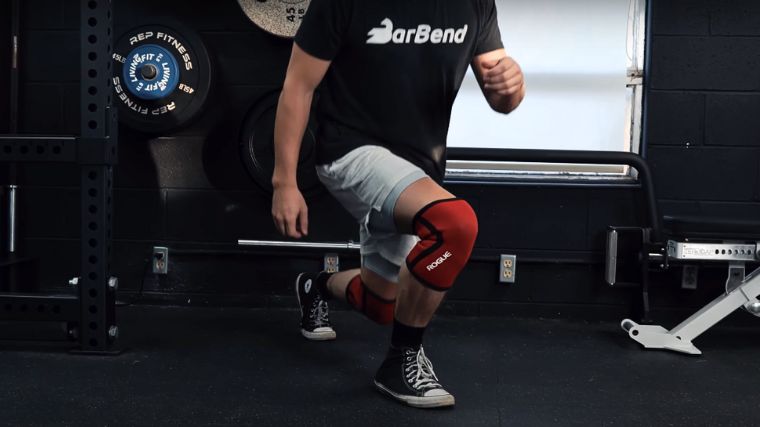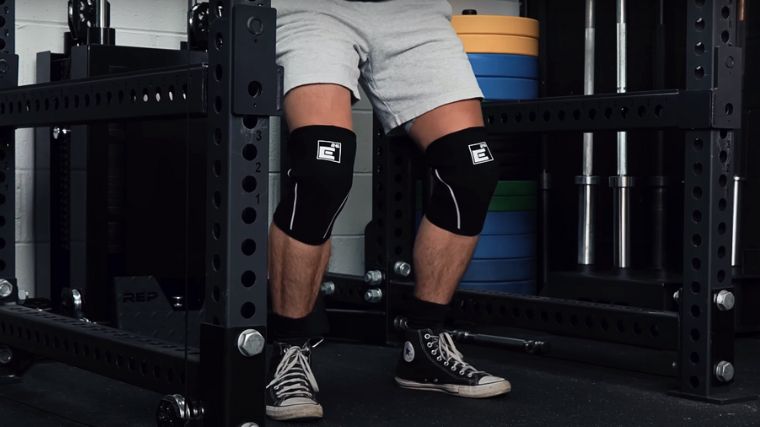Go running, they said. It’ll be good for you, they said. Your whole body will feel better, they said. Well, it did feel good. You love your new running shoes and the wind in your face is pretty different — in a good way — from the vibe of the dank, dark weight room. And then…your shins start feeling like they’re on fire.

Shin splints. The new bane of your existence. Your last battle with the pain of shin splints cranked your running routine to a halt. So how to prevent shin splints from cursing your regimen again? I called up physical therapist Heather Asti to get you the answers you need.
What Are Shin Splints?
While “shin splints” may sound like you’re referring to a splintered shin, it’s a simple way to refer to Medial Tibial Stress Syndrome (MTSS). Shin splints are an injury to the tibialis anterior — or the anterior (front) shin — the direct result of exercise. (1) While shin splints are not a literal splintering of your shins, it’s a serious tissue injury that can lead to bone tissue injury if left untreated. (2)
Backed by two decades of experience and several degrees in physical therapy, Asti knows plenty about what causes shin splints and how to prevent them.
[Read More: Why Do My Shins Hurt When I Run?]
“If you have shin splints, it means you’ve got a common overuse injury that plagues a lot of runners,” explains Asti. “When the distal tibia undergoes repeated loading, it damages the cortical bone and inflames the connective tissue that sits on top of the bone. If you don’t deal with the injury when you have the chance, usually by resting your legs, you can end up with a stress fracture.”
Symptoms of Shin Splints
It’s pretty obvious when shin splints start to rage. Of course, you’ll always want to check in with a qualified healthcare or sports medicine professional to clarify diagnosis and treatment plans.
But still, the signs of shin splints are typically isolated to some very specific areas, and they will have some rather precise characteristics that make the condition fairly easy to diagnose. (1)
- Mild swelling in the lower leg
- Pain in the front of your lower leg, especially during and after exercise
- Pain to the touch at your shin bone (front of your lower leg)
- Pain that improves when running ceases
Causes of Shin Splints
Shin splints are one of the most common running injuries out there. More likely than not, your risk of shin splints is heightened by one or more running-related conditions: (1)
- Sudden increases in running volume or frequency
- Sudden increases in running intensity
- Too much exposure to hard running surfaces
- Flaws in running form
Take careful note of the first two causes: sudden changes to your exercise routine. It’s pretty common for leg pain and other sports injuries to pop up when an athlete changes up their routine quickly and without preparing their body for the pressures of training.
[Read More: Best Leg Sleeves on the Market]
If you want to keep running pain-free — and without all the ibuprofen and other over-the-counter anti-inflammatories — gradual is key. Read on to find out exactly how to make that happen.
6 Tips for How to Prevent Shin Splints
Running is a complicated sport, but preventing shin splints doesn’t have to be all that difficult. Sure, injuries creep up on even the most cautious athletes on occasion, but the steps you can take to prevent shin splints are fairly straightforward. Let’s go down the line.
1. Avoid Major Mileage Increases
Yes, yes, everyone talks about the couch to 5K — but note that you’re not supposed to literally rise off the couch and immediately bang out a three-plus mile run. You’ve got to start off slow, only running a little bit (and not very fast) at a time until your heart, your body, your skeletal muscles, and your bones all acclimate to the new pressures you’re putting them under.

[Read More: Why Do My Knees Hurt When I Run? A Physical Therapist Explains]
You don’t want to majorly increase your mileage or speed overnight, or even over one week. Instead, try increasing your running volume by no more than 10 percent per week — and only if you feel ready. Much like with progressive overload in the weight room, if you’re increasing your volume (distance), don’t worry about getting faster. That will come during a different session.
“Muscles and bones respond [well] to a steady increase in training mileage by growing stronger,” says Asti. “But if you increase your running mileage by too much, and too soon, you’re placing your legs under the sort of stress that makes shin splints more likely.”
2. Train on a Softer Surface
By its very nature, running is a high-impact activity. Even with picture-perfect form and jogging on the best cushioned treadmills, the nature of the exercise is that you’re still bring your feet down against the pavement, track, dirt, or sand over, and over, and over again.
[Read More: How Many Steps in a Mile? Calculate by Height and Pace]
Fortunately, some running surfaces are more forgiving than others, and seeking them out can help you forego a painful case of shin splints. (1)
3. Don’t Overtrain On the Treadmill
In your search for a softer training surface to avoid shin splints, the treadmill might seem like a safe haven for your legs. And yes, treadmills are softer than the great outdoors. But some of the other risk factors of shin splints involve your form — so you’ll want to use caution on the treadmill.
[Read More: The Best Treadmills for Running]
“A treadmill surface is softer than pavement, but the treadmill belt pulls your foot backward at the very moment it hits the treadmill,” notes Asti. “In some cases, this can place even greater stress on your lower legs, because your body perceives it as being more like a downhill running pattern. It’s easier on your muscles than uphill running, but it can stress your legs in ways that aren’t obvious at first, and still result in shin splints.”
4. Swap Out Running With Other Cardio Exercises
No athlete wants to hear it, but yes indeed — taking a break from running can, indeed, help quite a lot. That doesn’t mean you have to stop cardio-related physical activity, though. You can simply swap out some planned running sessions with biking, rowing, or other cardio exercises. That way, you can rest those shins without your training coming to a screeching halt.
[Read More: The Best Cross-Training Shoes on the Market]
“One of the best ways to ensure your ability to continue to run without shin splints is to regularly cross-train [with other forms of cardio] to avoid placing extra stress on your legs,” advises Asti. “If you choose something like swimming or cycling, your medial tibias will have time to recover from the stress of running.”
5. Do Some Strength Training
The fact that shin splints are a connective tissue injury means that you have opportunities to strengthen that tissue and the surrounding muscles before impact with the ground causes trauma to the area. Strength training, specifically in your lower leg muscles, can preempt the likelihood of shin splints occurring. (3)

[Read More: The Best Leg Exercises for Muscle & Strength, According to a PhD]
“Lower body strength training is great for protecting your legs in general,” encourages Asti. “Anything that targets your glutes, your external and internal rotators, and your hip abductors is going to keep your quads and hamstrings strong and balanced, which reduces stress on your legs. But for shin splint prevention specifically, it is especially crucial to focus on the strength and flexibility of your calf muscles.”
6. Get Some Extra Help
No, orthopedics likely won’t solve your shin splint issue if you’ve suddenly jumped from running five miles a week to 10. After all, there’s only so much your shoes can do in the face of the sheer wear and tear you’re putting your body under. Still, some good shock-absorbing insoles or similar support wear might be up your alley.
“Sometimes you need additional arch support because you have flat feet, or maybe they’re overpronated,” observes Asti. “There are orthotics and shoes that you should look into to assure that the positioning of your foot is conducive to smooth running.” (4)
Frequently Asked Questions
Need to know more about shin splints? We got you covered.
What do shin splints feel like?
Shin splints are characterized by pain and tenderness in the middle of your shins, especially while you’re running.
How do you stop shin splints from forming?
The easiest ways to prevent shin splints from forming are by keeping your running volume stable, trying to minimize your exposure to hard training surfaces, and by stretching and strengthening your lower leg muscles. You can also invest in orthotic aids and supportive shoes if you have flat feet or high arches, which also contribute to shin splints.
Why do I get shin splints so easily?
You may get shin splints more easily than other people if you don’t allow your legs adequate time to rest, don’t stretch or strengthen your calf muscles, or continue to train on hard surfaces.
Is it OK to run with shin splints?
It is not advised that you run with shin splints. Continuing to run with shin splints often results in stress fractures. Instead, opt to wait it out, swap out your running sessions for more low-impact workouts, and double down on strength training and stretching.
What exercises prevent shin splints?
Calf muscles and stretches are specifically recommended to prevent shin splints. Aside from calf-specific strengthening exercises like calf raises, you’ll want to do some complete leg days to strengthen your entire lower body. Such a training plan can include exercises like squats, lunges, deadlifts, leg extensions, hamstring curls, and leg presses.
Editor’s Note: The content on BarBend is meant to be informative in nature, but it should not be taken as medical advice. When starting a new training regimen and/or diet, it is always a good idea to consult with a trusted medical professional. We are not a medical resource. The opinions and articles on this site are not intended for use as diagnosis, prevention, and/or treatment of health problems. They are not substitutes for consulting a qualified medical professional.
References
- Bhusari N, Deshmukh M. Shin Splint: A Review. Cureus. 2023 Jan 18;15(1):e33905. doi: 10.7759/cureus.33905.
- Galbraith RM, Lavallee ME. Medial tibial stress syndrome: conservative treatment options. Curr Rev Musculoskelet Med. 2009 Oct 7;2(3):127-33.
- Deshmukh NS Jr, Phansopkar P, Wanjari MB. A Novel Physical Therapy Approach in Pain Management and Enhancement of Performance in Shin Splints Athletes: A Case Report. Cureus. 2022 Jul 9;14(7):e26676.
- Gross ML, Davlin LB, Evanski PM. Effectiveness of orthotic shoe inserts in the long-distance runner. Am J Sports Med. 1991 Jul-Aug;19(4):409-12.